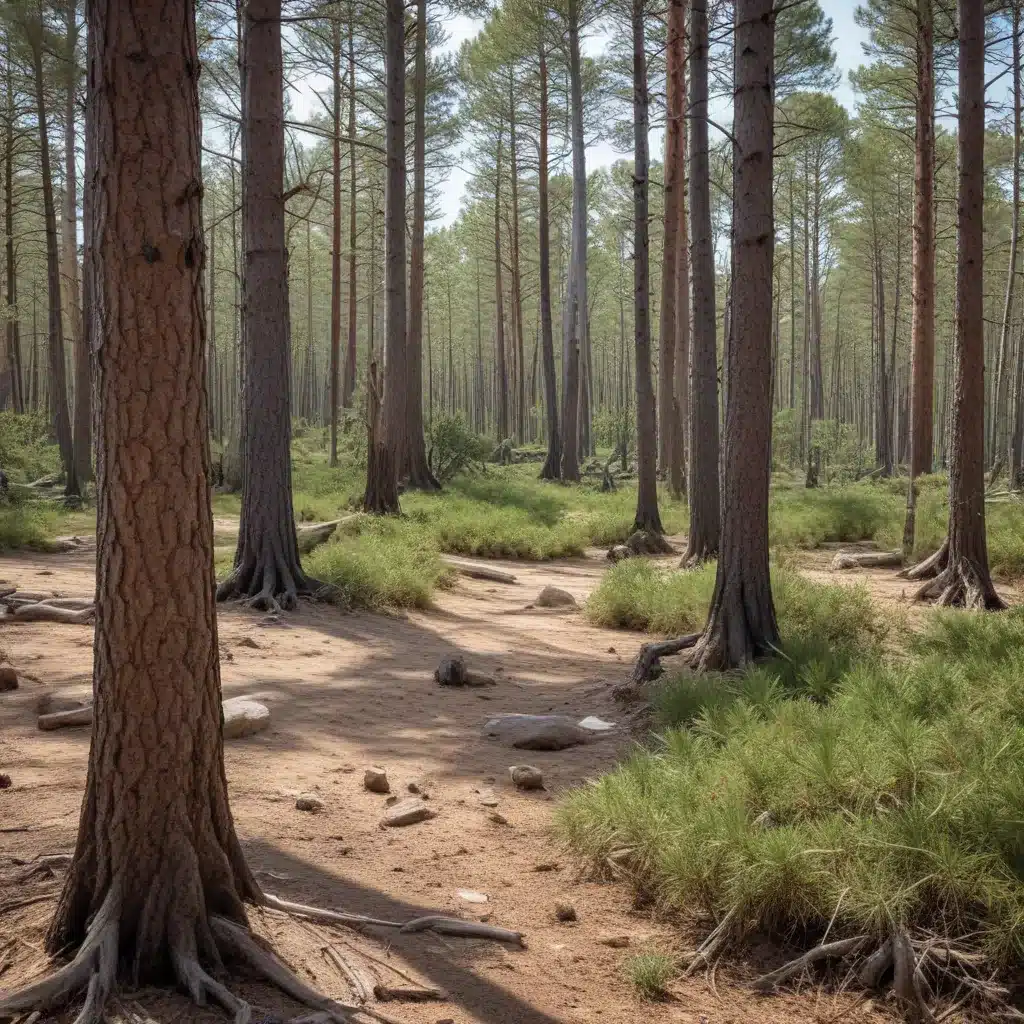
Exploring the Diverse Habitats Found Within Crooked Pines
Crooked Pines Farm is home to a remarkable diversity of natural environments, from lush coniferous forests to sprawling meadows and crystal-clear streams. As a farm educator, I’m excited to take you on a journey through the vibrant ecosystems that make up this dynamic landscape. Whether you’re a budding naturalist, a curious gardener, or simply someone who loves to immerse themselves in the great outdoors, this exploration will uncover the hidden wonders of Crooked Pines.
Forested Habitats
One of the most prominent features of Crooked Pines is its extensive network of forested areas. These wooded ecosystems are divided into three main types: coniferous forest, mixed forest, and deciduous forest.
The coniferous forest is dominated by towering pines, firs, and spruces, their evergreen needles providing a year-round canopy. These resilient trees have adapted to thrive in the region’s rugged climate, their deep taproots anchoring them firmly against the elements. Beneath the conifers, you’ll find a diverse understory of rhododendrons, mountain laurels, and other shade-tolerant shrubs, creating a lush, verdant landscape.
Transitioning into the mixed forest, you’ll encounter a blend of coniferous and deciduous species. Majestic oaks, maples, and hickories intermingle with the evergreen pines, resulting in a visually stunning patchwork of green, gold, and crimson foliage. This habitat is a prime destination for wildlife, offering a wealth of food and shelter for a myriad of creatures.
The deciduous forests of Crooked Pines are particularly revered for their vibrant autumn displays. Oaks, beeches, and birches shed their leaves in a dazzling array of colors, transforming the landscape into a veritable artist’s palette. These forests provide crucial resources for many species, from the acorn-hoarding squirrels to the nectar-sipping butterflies that flit among the wildflowers in the understory.
Grassland Habitats
Beyond the forested areas, Crooked Pines is home to a tapestry of grassland habitats, each with its own unique character and inhabitants. The meadows are carpeted with a lush, diverse array of grasses and wildflowers, attracting a plethora of pollinators and small mammals. These open spaces offer an ideal environment for children to explore the wonders of nature, learning about the intricate relationships between plants and the creatures that depend on them.
Interspersed within the meadows are pockets of prairie, with their characteristic tall grasses and deep-rooted vegetation. These resilient ecosystems are not only visually captivating but also play a crucial role in maintaining soil health and water quality. Families can enjoy meandering through the prairies, spotting the occasional bobcat or red fox darting between the tall stems.
In the more transitional areas, you may encounter savannas, where scattered trees dot the grassland landscape. These unique habitats provide a balance of open space and partial shade, supporting a diverse array of plants and animals that thrive in the ecotone between forest and prairie.
Aquatic Habitats
Winding through the heart of Crooked Pines are the freshwater streams of Crooked Creek and its tributaries. These vibrant waterways support a thriving population of native brook trout and stocked rainbow and brown trout, making them a popular destination for anglers. The cool, clear waters also provide essential habitat for a wide array of aquatic invertebrates, from delicate mayflies to tenacious crayfish.
Beyond the streams, Crooked Pines boasts a network of wetlands, where cattails, rushes, and other hydrophilic plants flourish. These lush, marshy areas are vital for maintaining water quality and providing refuge for a myriad of waterfowl, amphibians, and migratory birds. Visitors can explore the wetlands on carefully marked trails, keeping an eye out for the elusive great blue heron or the melodic calls of the red-winged blackbird.
Scattered throughout the property, you’ll also find a handful of ponds and lakes, each with its own unique character and inhabitants. These still-water habitats support a diverse array of aquatic life, from the vibrant dragonflies that skim the surface to the largemouth bass that lurk in the depths, waiting to strike.
Transitional Habitats
One of the most fascinating aspects of Crooked Pines is the presence of transitional habitats, where different ecosystems converge and intertwine. The riparian zones that line the streams and wetlands are a prime example, hosting a rich tapestry of plant and animal life that thrives at the water’s edge.
The ecotones, or boundary areas, between forested and grassland habitats are equally captivating. Here, you’ll find a unique assemblage of species that take advantage of the diverse resources and microclimates offered by these transitional zones. Keen-eyed observers may spot the chestnut-sided warbler or the rose-breasted grosbeak, both of which favor the “edge environments” where forest and meadow meet.
Biodiversity within Crooked Pines
The sheer diversity of habitats found within Crooked Pines has given rise to an impressive array of flora and fauna. From the towering conifers to the delicate wildflowers that dot the meadows, the plant life of this farm is a testament to the region’s natural abundance.
Mammalian wildlife abounds, with the elusive bobcat and black bear prowling the thickets, while the white-tailed deer and red fox make more frequent appearances. The skies above are alive with the songs of neotropical migrants, such as the scarlet tanager and the wood thrush, as well as the graceful vultures and hawks that soar on the updrafts.
Invertebrate life is equally vibrant, with a dazzling array of butterflies, dragonflies, and other pollinators that flit from bloom to bloom, pollinating the crops and wildflowers that form the foundation of this thriving ecosystem.
Whether you’re a seasoned naturalist or a curious newcomer, the diverse habitats of Crooked Pines offer endless opportunities for exploration, discovery, and an appreciation of the intricate web of life that sustains this remarkable farm. So pack your hiking boots, grab your binoculars, and join us on a journey through the rich tapestry of Crooked Pines’ natural wonders.


